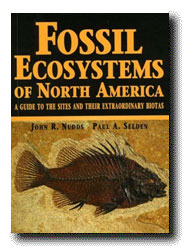
 FOSSIL ECOSYSTEMS OF NORTH AMERICA:
FOSSIL ECOSYSTEMS OF NORTH AMERICA:
A GUIDE TO THE
SITES AND THEIR EXTRAORDINARY BIOTAS
John R. Nudds and Paul A. Selden
University of Chicago Press, 2008
288 pp., $39.00 (paperback)
ISBN 13:978-0-26-60722-1
Paleontologists are in the business of finding fossils in just about any sedimentary rock, in pursuit of answers to all of the questions they have on how life has evolved on Earth. And, they know the typical taphonomic processes that preserve these fossils, which produce what could be called the “normal fossil record” of trace fossils and scattered pieces of whole organisms such as shells, bones and wood.
But, there is another fossil record, where the usual taphonomic rules seem to have been suspended, and what is preserved are soft tissues and cells as well as unusual concentrations of plant and animal remains. This “other fossil record” is the one that leads to huge public and private collections and the opening of museums dedicated to their display. This record of Lagerstätten is relatively scarce and yet provides much of what we know about how extinct organisms on Earth lived. This record is the subject of this new book by John Nudds and Paul Selden.
Everyone likes to visit the site of a Lagerstätte. And, if you are planning a summer road trip to the Lagerstätten of North America, this is the book that will be your guide. Fourteen sites in North America (including the amber of the Dominican Republic) are treated. And the range of Lagerstätten is broad, from Precambrian microbiotas of the Gunflint Chert to Pleistocene vertebrates of La Brea. For your road trip a unique component of this book includes directions to sites, descriptions on how to access them, and lists of museums which contain and display the fossils from each site.
To help you preview each site, chapters are profusely illustrated in color with images of important specimens and informative geological features. Of particular interest for each chapter is a section on the history of discovery and examination of the site, many of which have been known about since the nineteenth century. And, since the chapters are arranged in chronological order, the introductions to chapters place each site within the ongoing history of the evolution of life.
It is this scholarly context, which also includes discussions on the geological framework and paleoecological setting of each site, that makes this book of even greater utility. Indeed, it would serve well as a supplementary text to an undergraduate course on Historical Geology, Evolution, or Introductory Paleontology. This is likely much of the intent of the authors in producing this book, as they developed a companion book on global Lagerstätten as part of an undergraduate course they were teaching that used Lagerstätten case studies as a pedagogical tool.
All of these components make this a very versatile book. It is written and illustrated so that the public will find it of great use. And, it is also composed so that it will have great value in a university setting. These different elements are sure to produce a large audience for this latest book on Lagerstätten.